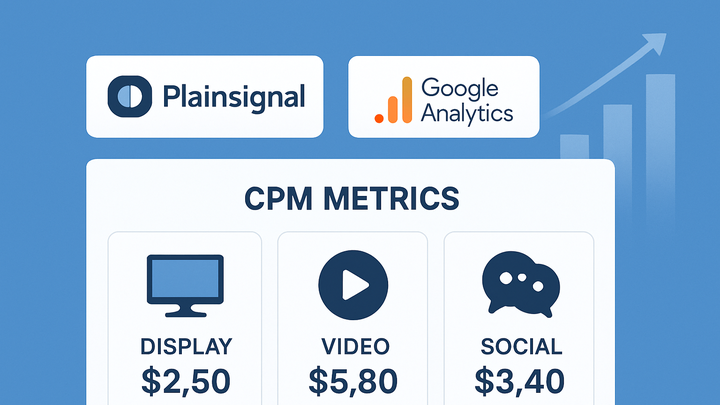Published on 2025-06-22T02:29:36Z
What is CPM (Cost Per Mille)? Analytics Definition & Examples
CPM (Cost Per Mille) is a key metric in digital analytics and advertising that measures the cost an advertiser pays per 1,000 ad impressions. It offers a standardized way to compare media buy costs across various channels, regardless of click or conversion volume. CPM is especially valuable for branding and awareness campaigns where maximizing reach is the primary goal. By focusing on impressions, CPM provides insight into the efficiency of spending in display, video, and social media advertising. Platforms like PlainSignal deliver cookie-free CPM tracking for privacy-focused analytics, while GA4 integrates cost and impression data through event-based measurement and Google Ads linking.
Cpm (cost per mille)
CPM measures the cost per 1,000 ad impressions, a vital metric for comparing advertising reach and spend efficiency.
Definition and Importance
CPM (Cost Per Mille) is a standard metric in digital marketing and analytics that represents the cost per thousand impressions of an advertisement. It helps marketers and publishers gauge the efficiency of ad spend relative to the number of times an ad is displayed. By focusing on impressions rather than clicks, CPM provides insights into brand awareness campaigns and display advertising where reach is key. Understanding CPM is crucial for budget allocation, performance benchmarking, and pricing negotiations with ad networks or publishers.
-
Cost per mille explained
“Mille” is Latin for “thousand,” so CPM measures how much you pay for every 1,000 ad impressions. An “impression” occurs each time an ad is fetched and displayed to a user. By using CPM, advertisers can understand the cost-effectiveness of reaching large audiences with display, video, or social media ads.
-
Why cpm matters
CPM is essential for campaigns focused on visibility and brand awareness. It allows direct comparison of costs across different channels and formats, informs bidding strategies in real-time ad auctions, and sets clear benchmarks for media buying.
Calculating CPM
Calculating CPM is straightforward and helps standardize cost comparisons across advertising channels. The formula takes your total ad spend and divides it by the number of impressions (in thousands), yielding a normalized cost metric that scales with your campaign size.
-
Cpm formula
Use the formula: CPM = (Total Cost / Total Impressions) × 1,000. For example, if you spend \(2,000 on an ad campaign that delivers 500,000 impressions, then CPM = (\)2,000 / 500,000) × 1,000 = $4.
-
Total cost
The complete amount spent on the ad campaign, including media fees and platform charges.
-
Total impressions
The raw number of times your ad was displayed, regardless of user interactions.
-
-
Sample calculation
Imagine a \(500 budget leading to 200,000 impressions: (\)500 / 200,000) × 1,000 = \(2.50 CPM. This means each thousand views of the ad cost \)2.50.
CPM in Analytics Platforms
Different analytics and ad measurement platforms offer built-in tools to track and report CPM. We’ll look at cookie-free tracing with PlainSignal and Google Analytics 4’s approach, highlighting integration steps and reporting nuances.
-
PlainSignal (cookie-free simple analytics)
PlainSignal provides a privacy-focused, cookie-free analytics solution. It can calculate CPM by combining your ad spend data with its lightweight impression tracking without relying on user-level identifiers.
-
Integration
Add the following code to your site to start collecting impression data and see CPM metrics in your PlainSignal dashboard:
<link rel="preconnect" href="//eu.plainsignal.com/" crossorigin /> <script defer data-do="yourwebsitedomain.com" data-id="0GQV1xmtzQQ" data-api="//eu.plainsignal.com" src="//cdn.plainsignal.com/plainsignal-min.js"></script> -
Dashboard view
Once integrated, PlainSignal’s UI surfaces CPM alongside pageviews, sessions, and other metrics, all without cookies or consent banners.
-
-
Google analytics 4 (GA4)
GA4 tracks user interactions and can link to Google Ads data to report CPM. It uses event-based data modeling, allowing flexible reporting of impression and cost metrics.
-
Setting up cpm in GA4
Link your Google Ads account to GA4, ensure ad impressions are tracked via the Ad Impressions event, and import cost data into GA4.
-
Reporting cpm
Navigate to the Advertising Snapshot or create a custom exploration in GA4, then add the ‘Cost per 1,000 impressions’ metric to see CPM across channels.
-
Best Practices and Considerations
While CPM is a powerful metric, it has limitations. It does not account for ad engagement quality or conversions and can be influenced by fraudulent or non-viewable impressions. Use CPM alongside other metrics and maintain data hygiene for accurate analysis.
-
Combining metrics for holistic insights
Pair CPM with metrics like CTR (Click-Through Rate), eCPM (Effective CPM), and conversion rates to understand campaign efficiency beyond pure reach.
-
Data quality and privacy implications
Cookie-free solutions like PlainSignal may show slightly different CPM values compared to cookie-based platforms due to differences in session attribution. Be mindful of privacy regulations and consent when interpreting CPM data.
